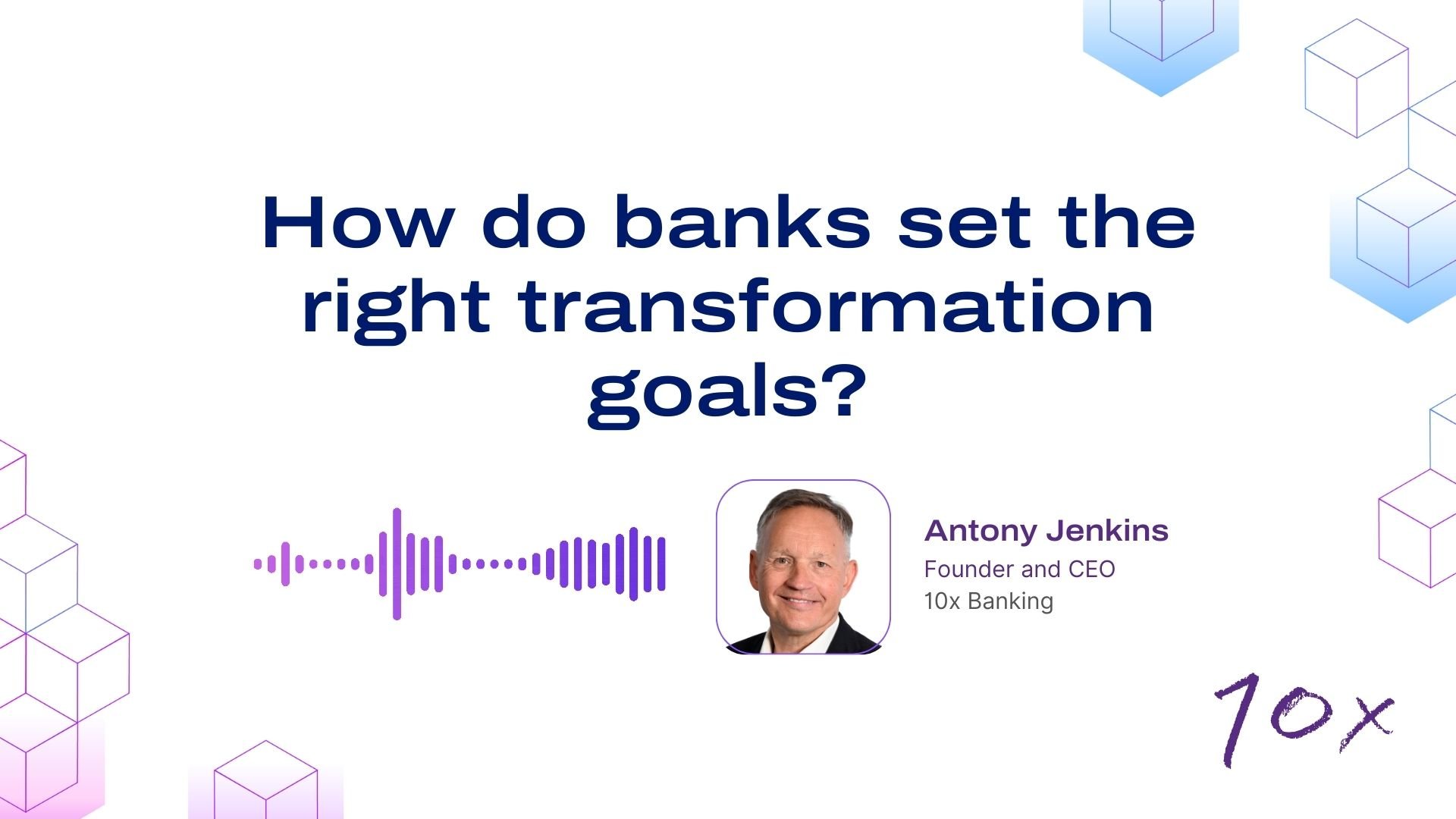This interview with Antony Jenkins, 10x Founder and CEO, looks at the challenges of legacy technology within corporate banking. He breaks down how better tech makes the life of a Corporate Treasurer easier, the best way to transform a bank, and the role of platform ecosystems in corporate banking.
For more on this subject, check out our report, How Corporate Banks can Transform the Treasury, which you can read here.
Why is a platform-based approach necessary for the future evolution of corporate banking?
AJ: Financial services products, in my opinion, fall into one of six categories.
You make or receive a payment. You can borrow or lend money. You can hold a savings product – either a simple product if you're a consumer, or a highly structured product if you're a wealth management customer. You can obtain an overdraft – again, a simple product if you're a consumer, or a complex collateralized piece of lending if you're a corporate.
The fifth category is that you manage risk. If you're an individual, you manage risk through insurance, and if you're a corporate, you might do so through a derivative. The final category is information on the first five products.
The industry has created a set of products often focused on a particular type of customer - a loan for a small business or a payment capability for an individual. However, functionally, these things are very much the same.
One of the keys to serving customers of banks ten times better – and at a tenth of the cost at a much faster speed - is to be able to recognize that. And then build a platform of functionality, a platform of services that allows you to deliver those six things faster, cheaper, and better.
What we've built at 10x is the capability to serve every type of customer of the bank from the individual to the large corporate, across all the asset and liability products through a combination of services that exist inside a platform. A great example is Salesforce. Salesforce has fantastic CRM capability, and we've taken that capability and built a big pipe with the platform so that when a colleague is dealing with a corporate's inquiry, they can look at the data residing in the platform on a real-time basis using Salesforce tools.
How do you view the platform being an enabler of this tech ecosystem?
AJ: All financial services products are just data. Sometimes there's a human being at the end of a transaction, but at the end of the day, the products themselves are represented by data.
Therefore, we need a very easy way of handling data, and that's why the way we build the platform is so key because we can stream data to our clients and third parties in real time.
We can ingest data in real time. Or, sometimes, we need to do that through batch processes, which is also fine if it's more efficient. The reason why that's important is for the first time ever, data experts – data scientists, for example – can look inside the platform, view clients' transactions and perform analysis in real time, and then send it back for actions and insights. This is very important because traditionally, data scientists have had to pull data out of multiple production systems, clean it up, and put it in a data lake before anything useful could happen, which was a highly inefficient and expensive process.
Enjoying the blog? You’ll love our report: How Corporate Banks can transform the Treasury. 
Relationship management is a key driver in corporate banking - how is technology improving things, in your view?
AJ: You can now see in real time that customers are taking balances away from you for liquidity management purposes or because they can get a better FX rate elsewhere, enabling you to make an intervention quite quickly. A core insight I've obtained over my long career in the industry is from my time in branch banking.
Branch banking back in the day was an integrated business. We served everybody, from students who had just arrived in the country to go to university to companies that were based locally. We served everybody.
The learning I took away from that was that dealing with your finances is just a chore for most people - and that's true from the individual to a Corporate Treasurer. There's nothing inherently valuable about financial services; it's what it enables. Nobody wants to get a mortgage; everybody wants to buy a house. Same for a corporate treasurer. Their job is to optimize the company's financial position across different accounts, legal entities, geographies, and currencies. Our job is to make their lives easier.
Nobody really cares about banking as an entity but only about what it can enable them to do in their lives. Therefore, the ability to make real-time decisions and execute transactions at high speed, and very low cost, is very important. And that's why this access to data becomes so important.
How do you define an outside-in approach to core banking and other systems?
AJ: The more we automate with technology, the better. I think there's always going to be a human dealing with that corporate treasurer, who can then be freed up to deal with the activities that really matter, helping with major challenges and decision-making around these challenges while proactively supporting them with their changing strategies. I founded this company because I knew there was a better way to serve my customers as a banker using technology. But frankly, I looked for it all over the world, and I couldn't find it.
So I decided to build it, starting with the question, 'what does the customer of a bank need?' How can we make their lives easier? How can we do banking ten times better, faster, and cheaper? And that was the outside perspective that we brought to the problem.
Our work is not to provide another core banking platform because that doesn't solve the problem. Yes, it might run on the cloud, so you don't have to run a data center anymore. So what? If you're still running the same 20-year-old code in the same highly ineffective architecture that you've been operating for the last 20 years, you're not going to get a 10x benefit from that. You might get a little bit of a benefit on the margin.
This platform has the key components of being architected around the customer, not around the product. Also, because we use microservices, we can quickly build new products. With this 'outside-in' approach, we can provide transformational capabilities to the bank.
Many banks follow a transformation model where you replace systems one by one, change the core banking to a newer core banking, etc. Does this work, in your opinion?
AJ: Let's take the example of a car. And you have added bits to it over the years. Now you need to replace the carburetor, or replace the engine block, in order to put a more efficient carburetor in there, and you'll get a bit more performance out of the car. That's one solution.
That's what's happened with banks deploying more services like mobile and internet. The car has become more complicated, and the solution is not – in our view – to replace the carburetor. Our solution is to have an electric vehicle with a 10th of the parts that an internal combustion engine has, which is basically a battery, a motor, and a set of brakes. That's the equivalent of 10x. It's much simpler, goes much faster, and is more environmentally friendly.
Finally, what do you think is the future of technology in corporate banking?
AJ: I don't believe banks should be trying to solve the problem of upgrading their core. They should be fundamentally implementing the bank operating system of the future, using a platform approach.
Platformification brings advantages like a customer-centric architecture, built-in services, and multi-tenant connectivity. We're all interested in technology. We are a technology company. But at the end of the day, the most important thing is people. All of our customers in banks are people, and all the people they serve are people. So the key to any change journey is about harnessing technology to serve people. We should use technology to empower our people to serve ten times better!
For more information on the changing face of corproate banking, check out our report, How Corporate Banks can transform the Treasury.



